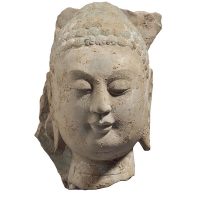Limestone head of Buddha with fragmentary halo
China, Northern Qi dynasty, 550 - 577
A limestone head of Buddha, the rotund face carved with arched eyebrows, downcast eyes with hooded eyelids, and a neat, symmetrical nose above a small mouth with pursed lips. The head is covered in tightly coiffed curls that resemble flower heads. The long, tapered neck has a horizontal groove. Attached to the head is a fragmentary halo, of which a circle and some lotus petals remain. The hair, neck and halo bear remnants of white and blue pigment and some hard encrustations of sand on the surface can be observed.
During the 6th century a more reserved, subtle style of Buddhist sculpture evolved from the preceding Northern Wei dynasty, a period in which sculptural images are often typified by subtly smiling features. At this time, facial expressions become more solemn, underscoring the serenity and spirituality of the subject matter. The earliest images of the Buddha often take the form of single statues. The tight curls in the hairdo, the column-like neck and the superbly accomplished treatment of the carving all exemplify the best of Northern Qi sculpture. The use of grey limestone is typical of the Qingzhou area of Shandong province. A larger head of the Buddha in a private collection in Taiwan has a similar facial expression and flower-shaped curls.[1]
Provenance:
Ben Janssens Oriental Art, October 2004
Private Collection, UK
1 Wai-shuang-hsi and Shih-lin, The Art of Contemplation – Religious Sculpture from Private Collections, National Palace Museum, Taipei, 1997, cat. no. 39, pp. 134 and 253
北齐/青州石雕佛头
此佛头包含部分颈部及背光。其螺发以浅雕而成,相对低平;面部线条饱满柔和,眉眼细长,其中眼部及唇部被重点刻画,线条起伏较大,符合北齐时期佛雕造像的特征。眼神呈俯视,面部表情呈微笑状,法相端庄吉祥。


